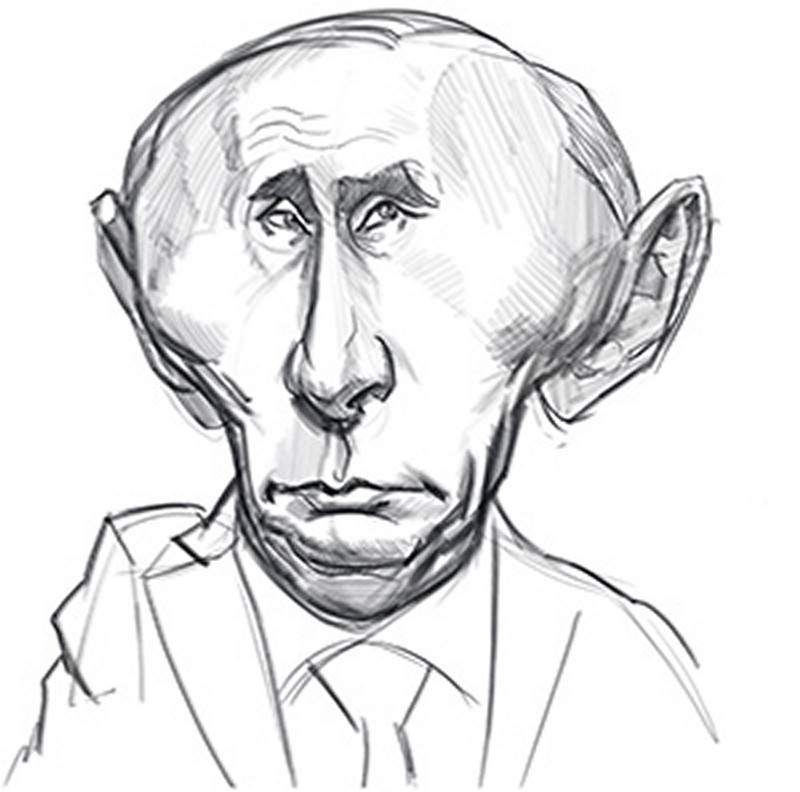In the last video, I showed my process for creating quick thumbnail sketches to explore shapes and find which exaggeration works best. In this video, I’ll be showing the next step: the rough sketch.
The Rough Sketch:
Thumbnail concept sketching was more about exaggeration and experimentation. But the rough sketch is all about the likeness. Although you can use this stage to push the exaggeration further, if you can get away with it. A rough sketch should be more structured and resolved than your thumbnails, but even at this stage, we won’t worry about making everything perfect because we’ll fix any drawing problems that come up, in the next step. For this lesson on the rough sketch, we’ll just focus on refining the likeness.
The Process:
The rough sketch is based off of the most successful thumbnail sketch. So, with my photo reference and my best thumbnail within view, I begin a new drawing, starting with the overall shape of the head. I’m trying to capture what made the thumbnail successful. What I really liked about my favorite thumbnail sketch was the light bulb shape of the head, where it’s wide on top and narrow on the bottom.

So I keep those proportions almost exactly the same in this rough sketch.
When working on your own, you may see an opportunity at this stage to push the exaggeration further. And that’s totally fine. Try to make improvements each time you re-sketch a face.
Here, I’m outlining the shape of the muzzle of the face. which helps me figure out where the eyes and top of the nose will go.
You should slow down when doing your rough sketch and think more consciously about fitting everything together.

A thumbnail sketch needs to be done quickly because it’s a product of your unconscious reaction to your subject’s likeness and personality. But a rough sketch needs more love and more careful observation of the reference photo. After I block in the rough shape of the head, I’m referring more to the photo to make my decisions, and less from the thumbnail. So just think of your thumbnail as a jumping-off point. Don’t feel you need to reproduce it exactly. Just take from it what works and try to expand on it.
My first few pencil strokes were light and loose. But now I’m starting to make more firm decisions about the shapes. At this point, I’m feeling pretty good about where it’s heading. If I wasn’t feeling good about it, I would probably still be darkening my lines to see how it turns out. And if I ended up missing the likeness on this one, I would just start again, because I haven’t invested too much time on this one. Originally, this whole sketch took me about 20 minutes. But it’s been sped up to just under five minutes here.

Right now, the placement and shapes of the features are all blocked in. I’ve been moving around the whole face, not spending too much time rendering an area until I’ve got the big picture figured out.
But now, I’m at the point, where I can start committing to my decisions, and I start shading using quick hatch strokes with my pencil. This helps to flesh out the flat shapes and give them volume.
In Putin’s head, it was important to show a small face on a very large bulbous head.
So there is a lot of empty space that I need to fill with plan changes to indicate the three-dimensional forms.
I’m relying both on observation from the photo, and my knowledge of the human skull.
It’s tempting to start drawing details since the likeness seems to be pretty strong now. But I remind myself that this is still a rough sketch. So I draw only enough to resolve the likeness.
In order to make this caricature as good as possible, I will be doing an extra step after this, to fix minor errors, before moving on to a final drawing.
That will be in the next lesson.

In the premium version of this lesson, I go into a lot more detail explaining my thoughts on my exaggeration choices on Mr. Putin.
But for now, take a look at the finished rough sketch. This is the point where I need to decide if it’s good enough to continue, or if I should just stop here and take it back to the thumbnail sketch phase.
On your own sketches, you need to be really honest with yourself. Because you don’t want to put any more time trying to render an unsuccessful rough sketch. If the likeness isn’t strong or if it’s not funny enough at this stage, go back to the drawing board.
So, to sum up, the basic steps to rough sketching, I:
- Block in the big head shape, the neck and shoulders.
- I establish a centerline.
- Sketch in the features using simple shapes first.
- Add shading.
Once I’m happy with size and placement, I begin roughly drawing the features and when I’m done, I decide if I can move forward or need to start over.
What’s Next?
In the next lesson, I’ll show how I make corrections and refinements to the rough sketch. It’s basically the secret to awesome caricatures. So don’t miss it
Premium Content
In the Premium version of this course, you’ll be able to watch a longer, more detailed version of this lesson along with several more narrated demonstrations of rough sketching different celebrity faces.
Assignment
If you’re following along in your studio, practice your own rough sketching by taking some of your best thumbnail sketches to the next level. Draw more carefully, but don’t worry about making them perfect. We’ll make them perfect later. Just make them good enough. Remember…baby steps.










